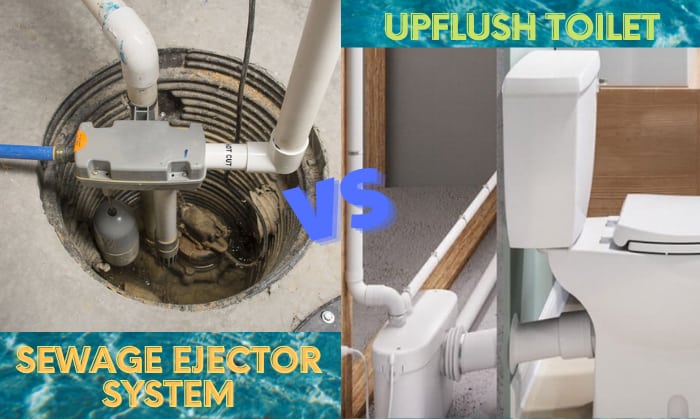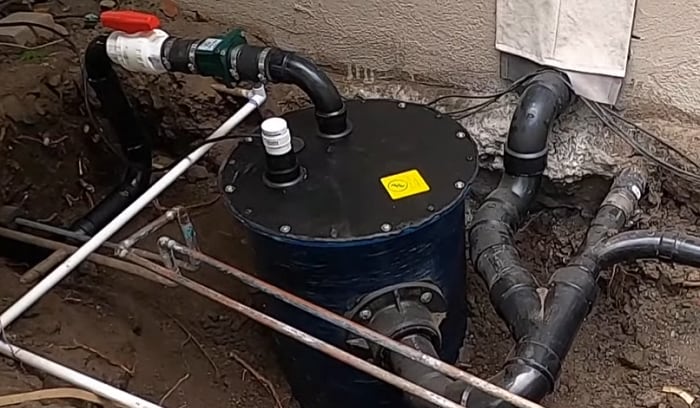It’s crucial to make sure that the waste from your toilet is disposed of properly. The waste should reach the drain without getting backed up to contaminate the water supply or cause clogging. This matter requires a better understanding of the sewage ejector system vs upflush toilet.
An ejector toilet system has a built-in pump that works when flushing the toilet. It stays functional even with regular use. Moreover, it’s well-hidden and durable. Meanwhile, an upflush toilet is easy to assemble and efficient in shredding the waste with a macerating tank. However, it requires more space.
Apart from this brief description of each system, there’s more to learn about them. Components, preparations, and detailed descriptions of functions are mentioned in this article for you to contemplate the appropriate system for your toilet.
Table of Contents
The Reality of Having a Sewage Ejector System
When you have an ejector pump toilet at home, the bathrooms and laundry room are typically located in the basement. The ejector pump is at a higher level when it runs through the sewer in the city. It can also be found in rural areas where the holding tank or drain field is higher than the plumbing. This setting is also referred to as above-ground sewage ejector systems.
The pump system is expected to be in a sump basin, and it’s just underneath your house. This sump can pump 30 to 40 gallons of waste each time. Since the drain lines are in the basement, they need to be sloped down to connect to the ejector pump. The wastewater will reach the pump, so the movement of the waste begins.
The up-flow pump takes the wastewater to the septic tank or sewer. The pump stops working once the toilet is empty while the float drops. It’s at rest and it begins to work once it’s full. Moreover, freestanding sewage ejector systems are common.
1. Codes and regulations
Before proceeding with your plant to have a toilet with an ejector pump, you need to talk to a plumber or inquire about codes and regulations from local building management. You have to do this as a permit may be required. Anyway, you’ll need help from a plumber to get a quality ejector pump and even a good septic tank if you have none.
2. Requirements when having a sewage ejector system
After confirming the codes and regulations with the authority and experts, you will also be aware of the requirements when setting up this system.
3. Vent
A vent is a must for a sewage ejector system. It assists in equalizing pressure during pumping or releasing the gas. You can place the vents on the roof or an existing vent.
4. Check valve
It’s another vital component to go with the sewage ejector pump. This part is attached to the outline pipe that connects to the main sewer line. The other function of this valve is to hinder the wastewater from returning to the toilet. It also does not let bad odors arise, making your bathroom smell like a sewer.
5. Size
Ejector pumps are in various sizes and you need to pick the suitable one. An average-size house requires a standard pump kit with a motor with ½ to ¾ HP. This motor can deal with 30 to 40 gallons of waste. It’s vital to get the right pump size to ensure that the wastewater won’t return to your toilet and make a foul-smelling bathroom. You can talk to your plumber about it.
Read more: 10 vs 12 inches rough in a toilet: which is better?
6. Budget
A toilet with a sewage ejector pump can cost from $400 to $1,000, depending on the brand and size. I’d like to recommend Superior Pump and Zoeller Waste Mate since they prove to be of high quality and dependable. Don’t prioritize the price as bad products can result in frequent repairs. It will give you a hard time as fixing can’t restore its functioning state. Instead, replacement is necessary.
What You Need to Know About Upflush Toilet
The majority of flushing systems utilize pressure or gravity. However, it doesn’t apply with an upflush toilet, an alternative to a sewage ejector pump. But it has a pump and an additional macerating tank. With the blade inside the tank, the shredding of waste takes place. After this process, the waste gets into the main drain line.
The upflush sewage pump is mounted behind a wall and it has an extension pole so it can be connected to the toilet. In some cases, it sits as a unit behind the toilet. Since it doesn’t depend on gravity to work, it can be placed below the mainline, basements, and even on sailing boats or off-the-grid homes.
Pros:- It can be installed near the mainline and other places that were mentioned. This flexibility is a big advantage. It can pump liquid waste 150 feet horizontally and 15 feet vertically.
- An upflush toilet is portable, and it’s easy to install. Moreover, you can relocate it if necessary by just undoing the screws and putting them back.
- The average lifespan of this toilet is 10 to 15 years, but it can be longer when there’s proper maintenance.
- Having an upflush toilet can save you some money since it’s water-efficient. You can avoid having a high water bill. The expenses are lower than hiring a plumber to install a traditional toilet.
- This toilet won’t alter the aesthetics of your bathroom.
- The maintenance of an upflush toilet is not demanding as you‘ll need to replace the tank in 10 years or more.
- The initial cost of installing an upflush toilet could be high, especially if you got the quality one. But it’s worth it since it can serve in the long run.
- It can be noisy when the tank shreds the waste. You can put it in an area where the noise won’t be too obvious to counter this issue.
- Unfortunately, the tank won’t work if there’s no electricity.
- An upflush toilet is not for frequent use or a number of people. If it’s overworked, the pump gives up.
Which Would Be Better for You: Sewage Ejector System or Uplush Toilet?
1. Cleanliness
This factor concerns users before and after installation. It’s given that an upflush toilet is easy to set up, but it’s not as clean as ejector systems. They contribute to the cleanliness as they don’t take up any bathroom space.
2. Consistency of Efficiency
It’s again in favor of the sewage ejector because it can accommodate a considerable waste. It activates in an instant. This function may not be too different from an upflush toilet. But it needs to complete an additional process through the macerating tank. The ability of the tank to break down the waste is not consistent all the time. Overworking is not even good for it.
3. Durability
They can be both durable if they are installed properly. Of course, regular maintenance will prolong the life of any of these systems.
Summary
You now know how to install and prepare these toilet systems. In the sewage ejector system vs upflush toilet, you can have the former if you can fulfill its requirements. The latter is fine if your toilet doesn’t carry the bulk of waste all the time. It’s good as you have more options of areas where you can place it.

I’m Paulk Webb, and I work as a writer for Saveourwaterrebates. I’m happy to put in the time and effort to conduct market research to identify the most pressing issues faced by households concerning their plumbing. Feel free to check out our guides to get the most informed recommendations for how to solve your problems.




